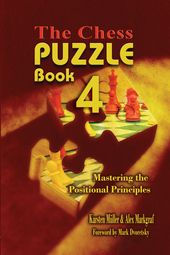Chess Puzzle Book 4
Mastering the Positional Principles
Alex Markgraf, Karsten Muller

Chess Puzzle Book 4: Mastering the Positional Principles by Karsten Muller and Alex Markgraf is a solid no-nonsense guide to improving ones positional play. The six chapters (Prophylaxis, The Principal of Two Weaknesses, The Right Exchange, Domination, Do Not Rush and Converting an Advantage) are arranged according to the following formula: 1.Introduction of the theme. 2.Thematic examples. 3.Positions to solve. 4.Detailed solutions.
The examples and positions to solve are drawn from both current practice and old classics. They feature in-depth annotations that are a mixture of prose and analysis making this book accessible to a wide audience.
One example that has always intrigued me and which has appeared in several books is an old Botvinnik gem which Muller and Markgraf include in the chapter, The Principle of Two Weaknesses. The position in the book starts after Blacks 24th move.
Reti A13
Mikhail Botvinnik Evgeny Zagoriansky
Sverdlovsk 1943
1.Nf3 d5 2.c4 e6 3.b3 Nf6 4.Bb2 Be7 5.e3 00 6.Nc3 c5 7.cxd5 Nxd5 8.Nxd5 exd5 9.d4 cxd4 10.Qxd4 Bf6 11.Qd2 Nc6 12.Be2 Be6 13.00 Bxb2 14.Qxb2 Qa5 15.Rfd1 Rad8 16.Rd2 Rd7 17.Rad1 Rfd8 18.h3 h6 19.Ne5 Nxe5 20.Qxe5 Qc5 21.Bf3 b6 22.Qb2 Rc8 23.Qe5 Rcd8 24.Rd4 a5
The first two steps of Whites plan have already been achieved creating a weakness and taking aiming at it. White must now decide how to continue. Blacks position has only one weakness. All Whites pieces take aim at d5, but this alone is not sufficient to break through. The key to this position is not the weakness itself, but the fact that Blacks pieces are tied to passive defense. So they are not flexible and cannot regroup quickly. Whites pieces are much more mobile. They can move on both flanks quickly and back again (e.g., Rd4-a4-g4-d4 ). To take advantage of this flexibility White has to create another weakness.
25.g4!!
Botvinnik: Blacks pieces are tied to the defense of the d5-pawn. This allows White to start an attack on the kingside, even if this also weakens Whites king position. But Black can start no real counterattack. His pieces lack space and cannot exploit the advance of the g-pawn. Whites major pieces will create strong pressure after the g-pawn has been used as a battering ram.
25 Qc6 26.g5 hxg5 27.Qxg5 f6 28.Qg6 Bf7
28 Bh3? 29.Rf4 Rd6 30.Kh2 Be6 31.Rg1 Qb7 32.Qh6 gives White a clear advantage.
29.Qg3 f5?
This rushed advance only helps Whites initiative. But the transfer of Whites rook to g1 poses Black unsolvable problems anyway. (Botvinnik). 29 Qc2 30.Be4 Qc6 31.Bd3 gives White a lasting initiative.
30.Qg5 Qe6 31.Kh1 Qe5 32.Rg1!
Increasing the pressure is stronger than 32.e4? Be6 33.exd5 Bxd5 34.Bxd5+ Rxd5 35.Qxd8+ Rxd8 36.Rxd8+ Kh7. One reason is that Blacks position is much more difficult to play in the game.
32 Rf8
32 Rd6 33.Rf4 Bg6 34.h4 with a clear advantage.
33.Qh6 Rb8?
33 Rc8 34.Rh4 Kf8 35.Qxb6 Rc2 36.Kg2 with a clear advantage. 33 g6 34.Rxg6+ Bxg6 35.Qxg6+ Rg7 36.Qxb6 Rc8 37.Bxd5+ Kh8 38.Bc4 with a clear advantage.
34.Rh4 Kf8 35.Qh8+ Bg8 36.Rf4
The new target, the f5-pawn, cannot be defended in a satisfactory way.
36 Rbb7 37.Rg5 Rf7 38.Qh5 Qa1+ 39.Kg2 g6 40.Qxg6 Bh7 41.Qd6+ Rfe7 42.Qd8+, 10.
The questions I have always asked since playing over this game for the first time is: 1.Would this position be winnable if Blacks pawn had remained on h7? 2.Was 18 h6 in effect the losing move?
Recommended
